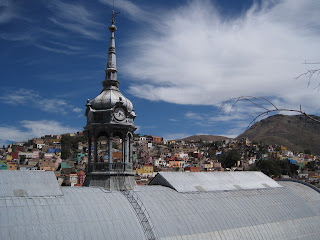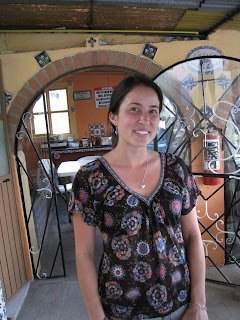Guanajuato is steeped in Cervantes. It has a three week Cervantes festival every October. Its streets are full of statues and other allusions to Don Quixote and his faithful squire. There is an entire museum dedicated to paintings and sculptures of their likenesses. When you get to know Guanajuato you can see why. It is the most quixotic of cities, improbable, enchanting, and beautiful.
Guanajuato seems to have no plan and to make no sense. It is built along a narrow valley in the geographical center of Mexico. Its attractive, sometimes bizarre, multicolored buildings seem piled on top of each other, lining streets that wind up the steep hills, often turning into meandering stairwayed alleys. Not one street is straight. But wandering through them is like wandering through an intricate but lovely fairy tale or a story by Jorge Borges or Italo Calvino. It is a labyrinth, made even more complex by a series of stone tunnels that snake about under the city. Here the traffic flows where the diverted rivers once did. It is like something an ingenious child, possibly headed for schizophrenia later in life, might build out of Legos.
It is also a city with interesting history. It was built on the wealth of one of the world's great silver mines. Father Miguel Hidalgo ignited the Mexican war of independence in the nearby village of Dolores, 200 years ago, with an incendiary speech know as El Grito de Dolores (The Cry of Dolores). He soon led his troops to Guanajuato where the Spanish troops barricaded themselves in a grain storage building called the Alhóndiga de Granaditas. They were finally overcome when a miner, nicknamed Pípila, wearing a stone slab on his back as armor from bullets, rushed the Alhóndiga and set the doors ablaze, allowing the revolutionaries to storm the place. The Alhóndiga is now a museum with plaques on each corner where the Spanish hung the heads of important captured revolutionaries, including Hidalgo's. A strange modern statue to Pípila with torch in hand watches over the city with the inscription: "Aun hay otras Alhóndigas por incendiar" (There are still other Alhóndigas to burn).

















































Not only is Guanajuato a magical maze-like city but we found a magical maze-like hostel, the Casa Bertha, owned and run by the smiley brothers Juan and Jorge. We rented a small apartment, cooked most of our meals, and stayed more than a week. It was wonderful to feel like we had a home again, even for a short time.
The homelike atmosphere was enhanced by the quality of the people staying there. The oldest, Oz, is a physicist in his 80s, born in Germany, with a wide range of interests. The youngest, Isang, is a bright and mature 22. She is studying Spanish and preparing to bike from Seattle, Washington to Washington D.C. for the American Lung Association. Check out her websites: isangsbikeride.com and mas2186.wordpress.com.
We spent a lot of time with Lyall and Josh, two guys from the States, about our age who quickly seemed like old friends. We also became close with Terry and Diana from Vancouver and Dan from North Dakota. We enjoyed several afternoons and evenings up on the deck overlooking the city, talking with them about everything from politics to mining (Terry is a retired mining engineer).
These are pictures from Jorge's birthday party:










The area around Guanajuato is beautiful as well. We spent a couple days exploring with our friends from the hostel. On the first we walked up to the holy miradors (peaks with crosses) with fantastic views of the city. The next, we walked four hours along a dirt road to the small town of Santa Rosa, passing through other small mining towns and meeting several animals. We had a delicious meal in Santa Rosa before returning by bus.




























On Saturday night Terry and Diana invited us to join them at a Cervantes play held in the plaza in front of one of Guanajuato's churches. We didn't understand much but the costumes were spectacular and the actors were excellent physical comedians. A few times actors would enter the "stage" on horseback. There was even a sword fight.
Later Josh took us to a great live music venue called Zilch, owned by Michael from Worcester, Mass. who also plays cello in the Guanajuato Symphony. The band played powerful funk and jazz. All the musicians were great but the trumpeter, the drummer, and the bassist stood out. One of the solos by the trumpeter started out with weird, low, flatulent sounds and built to ecstatic war blasts. Fantastic.







We had been to Guanajuato before when we came to Mexico for Fay and Jeff's wedding at a nearby hacienda. We had wanted to hit a real Mexican cantina and picked a place with swinging doors with the letters FBI cut into them. Hilary walked in first and started to greet the bartender in her (then) very limited Spanish, when I saw the exposed urinal on the wall next to the bar and decided our company wasn't desired. I put my hand on her shoulder and led her back out.
It turns out to have been a mistake. Josh and Lyall took us to the Famoso Bar Incendio and it turned out not only to welcome women but to be one of the friendliest bars in Latin America. Each time we met several locals and were always greeted with smiles. On our final night we met a political science student named Juan Pablo and his friends Diego and "Taliban". When the bar closed we went back to their student digs and kept the party going until the wee hours. A forty year-old shouldn't try to keep up with college students, but we couldn't resist. Lyall, Hilary, and I walked home after two in the morning barking back at the neighborhood dogs.
The next day, Hilary and I left for Zacatecas feeling a bit like the Knight of the Rueful Figure after one of his less successful sallies or Sancho Panza after his blanketing, and missing our little home in Guanajuato.













2 comments:
What a great experience! I appreciate that through words and pictures, you give a window into different worlds. Muchas Gracias!
You guys could totally do a little book entirely on the dogs that you have come across in the past year.
I also would like to know what camera you are using.
Keep having a safe and fun time!
Covington (formerly Cincinnati) Mary
PS - also secretly want to know what comment inspired comment moderation to be enabled...:)
Post a Comment